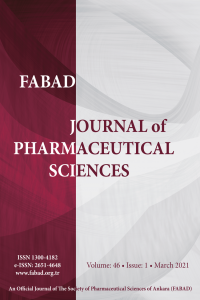Ifosfamide-Loaded Cubosomes: An Approach to Potentiate Cytotoxicity against MDA-MB-231 Breast Cancer Cells
Ifosfamide-Loaded Cubosomes: An Approach to Potentiate Cytotoxicity against MDA-MB-231 Breast Cancer Cells
Breast cancer, ifosfamide, cubosomes, haemolysis, cytotoxicity, cellular uptake,
___
- Addeo, R., Faiola, V., Guarrasi, R., Montella, L., Vincenzi, B., Capasso, E., Cennamo, G., Rotundo, M. S., Tagliaferri, P., Caraglia, M., Del Prete, S. (2008). Liposomal pegylated doxorubicin plus vinorelbine combination as first-line chemotherapy for metastatic breast cancer in elderly women > or =65 years of age. Cancer chemotherapy and pharmacology, 62(2), 285–292. https://doi.org/10.1007/s00280-007-0605-6.
- Alavi, M., Webster, T. J. (2020). Nano liposomal and cubosomal formulations with platinum-based anticancer agents: therapeutic advances and challenges. Nanomedicine (London, England), 15(24), 2399–2410. https://doi.org/10.2217/nnm-2020-0199.
- Almotwaa, Sahar. (2021). Coupling Ifosfamide to nanoemulsion-based clove oil enhances its toxicity on malignant breast cancer and cervical cancer cells. Pharmacia, 68. 779-787. http://dx.doi.org/10.3897/pharmacia.68.e68291.
- Andrgie, A. T., Birhan, Y. S., Mekonnen, T. W., Hanurry, E. Y., Darge, H. F., Lee, R. H., Chou, H. Y., Tsai, H. C. (2019). Redox-Responsive Heparin-Chlorambucil Conjugate Polymeric Prodrug for Improved Anti-Tumor Activity. Polymers, 12(1), 43. https://doi.org/10.3390/polym12010043.
- Behzadi, S., Serpooshan, V., Tao, W., Hamaly, M. A., Alkawareek, M. Y., Dreaden, E. C., Brown, D., Alkilany, A. M., Farokhzad, O. C., Mahmoudi, M. (2017). Cellular uptake of nanoparticles: journey inside the cell. Chemical Society Reviews, 46(14), 4218–4244. https://doi.org/10.1039/c6cs00636a.
- Bhat, S. S., Revankar, V. K., Kumbar, V., Bhat, K., Kawade, V. A. (2018). Synthesis, crystal structure and biological properties of a cis-dichloridobis(diimine)copper(II) complex. Acta Crystallographica. Section C, Structural Chemistry, 74(Pt 2), 146–151. https://doi.org/10.1107/S2053229617018551.
- Craig, C., Julia N, Tim W. (2008).The side effects of chemotherapeutic agents. Current Anaesthesia Critical Care, 19(2), 70–79.
- Elakkad, Y. E., Mohamed, S., Abuelezz, N. Z. (2021). Potentiating the Cytotoxic Activity of a Novel Simvastatin-Loaded Cubosome against Breast Cancer Cells: Insights on Dual Cell Death via Ferroptosis and Apoptosis. Breast Cancer (Dove Medical Press), 13, 675–689. https://doi.org/10.2147/BCTT.S336712.
- Escalante, J., McQuade, R. M., Stojanovska, V., Nurgali, K. (2017). Impact of chemotherapy on gastrointestinal functions and the enteric nervous system. Maturitas, 105, 23–29. https://doi.org/10.1016/j.maturitas.2017.04.021.
- García-Pinel, B., Porras-Alcalá, C., Ortega-Rodríguez, A., Sarabia, F., Prados, J., Melguizo, C., López-Romero, J. M. (2019). Lipid-Based Nanoparticles: Application and Recent Advances in Cancer Treatment. Nanomaterials (Basel, Switzerland), 9(4), 638. https://doi.org/10.3390/nano9040638.
- Gustafsson, J., Ljusberg-Wahren, H., Almgren, M., Larsson, K. (1996). Cubic lipid-water phase dispersed into submicron particles. Langmuir, 12, 4611–3. https://doi.org/10.1021/LA960318Y.
- Hosseinzadeh, B. E., Nasri, S., Rahale, M. (2020). Thymoquinone-loaded ethosome with breast cancer potential: optimization, in vitro and biological assessment. Journal Nanostructure Chemistry, 10, 19–31.
- Kumbhar, P.S., Sakate, A.M., Patil, O.B. et al. Podophyllotoxin-polyacrylic acid conjugate micelles: improved anticancer efficacy against multidrug-resistant breast cancer. Journal of Egyption National Cancer Institute, 32, 42 (2020). https://doi.org/10.1186/s43046-020-00053-1.
- Lakshmi, N. M., Yalavarthi, P. R., Vadlamudi, H. C., Thanniru, J., Yaga, G., K, H. (2014). Cubosomes as targeted drug delivery systems - a biopharmaceutical approach. Current Drug Discovery Technologies, 11(3), 181–188. https://doi.org/10.2174/1570163811666140505125923.
- McQuade, R. M., Stojanovska, V., Donald, E., Abalo, R., Bornstein, J. C., Nurgali, K. (2016). Gastrointestinal dysfunction and enteric neurotoxicity following treatment with anticancer chemotherapeutic agent 5-fluorouracil. Neurogastroenterology and Motility: The Official Journal of the European Gastrointestinal Motility Society, 28(12), 1861–1875. https://doi.org/10.1111/nmo.12890.
- Mohamed, N., Mohamed, K.,Ghoraba, AA. (2015). In vitro and in vivo evaluation of cubosomes containing 5-fluorouracil for liver targeting. International Journal of Applied Pharmaceutics, 5(1),79–88.:http://dx.doi.org/10.22159/ijap.2019v11i2.30582.
- Noujaim, J., Constantinidou, A., Messiou, C., Thway, K., Miah, A., Benson, C., Judson, I.,Jones, R. L. (2018). Successful ifosfamide rechallenge in soft-tissue sarcoma. American Journal of Clinical Oncology, 41(2), 147–151. https://doi.org/10.1097/COC.0000000000000243.
- Rick D, Kellerman MD. (2021). In conn's current therapy. Elsevier, 1165-1168.
- Sambamoorthy, U., Manjappa, A. S., Eswara, B., Sanapala, A. K., Nagadeepthi, N. (2021). Vitamin E Oil Incorporated Liposomal Melphalan and Simvastatin: approach to obtain improved physicochemical characteristics of hydrolysable melphalan and anticancer activity in combination with simvastatin against multiple myeloma. AAPS PharmSciTech, 23(1), 23. https://doi.org/10.1208/s12249-021-02177-6.
- Singh-Joy, S. D., McLain, V. C. (2008). Safety assessment of poloxamers 101, 105, 108, 122, 123, 124, 181, 182, 183, 184, 185, 188, 212, 215, 217, 231, 234, 235, 237, 238, 282, 284, 288, 331, 333, 334, 335, 338, 401, 402, 403, and 407, poloxamer 105 benzoate, and poloxamer 182 dibenzoate as used in cosmetics. International Journal of Toxicology, 27 Suppl 2, 93–128. https://doi.org/10.1080/10915810802244595.
- Suwankhong, D., Liamputtong, P. (2018). Physical and Emotional Experiences of Chemotherapy: A qualitative study among women with breast cancer in Southern Thailand. Asian Pacific Journal of Cancer Prevention: APJCP, 19(2), 521–528. https://doi.org/10.22034/APJCP.2018.19.2.521.
- Wang, S. Q., Zhang, Q., Sun, C., Liu, G. Y. (2018). Ifosfamide-loaded lipid-core-nanocapsules to increase the anticancer efficacy in MG63 osteosarcoma cells. Saudi Journal of Biological Sciences, 25(6), 1140–1145. https://doi.org/10.1016/j.sjbs.2016.12.001.
- Zhang, J., Ng, K. Y., & Ho, P. C. (2010). Interaction of oxazaphosphorines with multidrug resistance-associated protein 4 (MRP4). AAPS PharmSciTech, 12(3), 300–308. https://doi.org/10.1208/s12248-010-9189.
- ISSN: 1300-4182
- Yayın Aralığı: Yılda 3 Sayı
- Başlangıç: 2005
- Yayıncı: FABAD Ankara Eczacılık Bilimleri Derneği
Yalçın ERZURUMLU, Deniz ÇATAKLI, Hatice Kübra DOĞAN, Esra AYDOĞDU
Burcu ÜNLÜ ENDİRLİK, Elçin BAKIR, Arzu YAY, Fazile CANTÜRK TAN, Ayşe BALDEMİR KILIÇ, Ayşe EKEN
Swapnil CHOPADE, Santosh A. PAYGHAN
Shabnam NAZİR, Hina RAZA, Memoona NİSAR, Zermina RASHİD, Rahat SHAMİM, Bushra ALAM, Amjad KHAN
Martha Nneoma OFOKANSİ, Ogechukwu N ISİOGUGU, Ikechukwu E PETER, Matthas AGBO, Festus B.c. OKOYE, Peter A AKAH
Popat KUMBHAR, Vıshvajıt KHADE, Varsha KHADAKE, Pradnya MARALE, Arehallı MANJAPPA, Sameer NADAF, Vıjay KUMBAR, Durgacharan BHAGWAT, John DİSOUZA
Investigation of Age-Related Alterations in Brain and Serum Samples in a Healthy Aging Rat Model
Ece TÜRKMEN, Selin PARMAKSIZ, Mustafa ÇELEBİER, Sevda ŞENEL
Development and Evaluation of Nanostructured Lipid Carriers for Transdermal Delivery of Ketoprofen
Thulasi SATHYANARAYANA, Preethı SUDHEER, Elsa JACOB, Merlin Mary SABU
